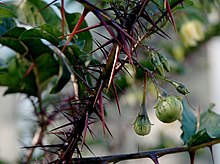| Solanum atropurpureum | |
|---|---|

| |
| Scientific classification | |
| Kingdom: | Plantae |
| Clade: | Tracheophytes |
| Clade: | Angiosperms |
| Clade: | Eudicots |
| Clade: | Asterids |
| Order: | Solanales |
| Family: | Solanaceae |
| Genus: | Solanum |
| Species: | S. atropurpureum |
| Binomial name | |
| Solanum atropurpureum L. | |
Solanum atropurpureum, commonly known as malevolence, purple devil and the five-minute plant, is a perennial herbaceous plant native to Brazil. S. atropurpureum contains various toxic tropane alkaloids in its fruit, stems, and leaves, and should not be ingested.
The plant is a small shrub growing 1.2 to 1.8 meters in height and 90 to 120 cm in width with ovate, spade shaped leaves 5 to 10 cm long when fully grown. It blooms yellow to white flowers in the late spring to mid summer, and produces small (1–2 cm wide) orange fruit. The fruit's juices can be irritating to the touch, so it is recommended that gloves be used when removing or handling. The plant is short lived with a 3 to 5-year lifespan. The plant is characterized by its purple stems, which are completely covered by striking purple and green thorns about 2 cm long, from which its common names are ostensibly derived. These are known as 'prickles' and are not present on its edible eggplant cousin, due to differences in the LOG gene.
The plant can be grown ornamentally, requiring full sun and modest water. The plant is known to grow in a wide variety of soils and can resist temperatures as low as −10 °C (14 °F) for a few days. Seeds can be harvested from the fruits, and stem cuttings can be used to grow the plant in about 10 to 20 days.
It is also known as a natural reservoir of the potato virus X.
Gallery
References
- Appell, Scott D. (1 March 2003). Annuals for Every Garden. Brooklyn Botanic Garden. p. 35. ISBN 978-1-889538-57-0. Retrieved 3 September 2012.
- Satterlee, J.W.; Alonso, D.; Gramazio, P. (2024). "Convergent evolution of plant prickles by repeated gene co-option over deep time". Science. 385 (6708): 1663. doi:10.1126/science.ado1663. PMC 11305333. PMID 39088611.
- Zimmer, Carl (August 1, 2024). "How Did Roses Get Their Thorns?". The New York Times. Retrieved 1 September 2024.
- Chagas, C.M.; Vicente, Marly; Alba, A.P.C.; July, J.R. (October 1977). "Solanum atropurpureum Schrank, a Natural Reservoir of Potato Virus Y (PVY)". Journal of Phytopathology. 90 (2): 147–151. doi:10.1111/j.1439-0434.1977.tb03230.x.
External links
| Taxon identifiers | |
|---|---|
| Solanum atropurpureum |
|
This Solanales article is a stub. You can help Misplaced Pages by expanding it. |

